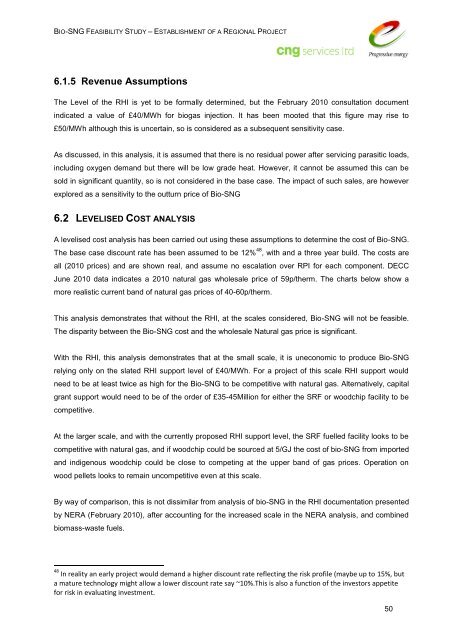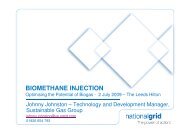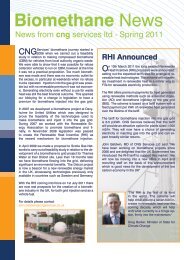Bio-SNG - CNG Services
Bio-SNG - CNG Services
Bio-SNG - CNG Services
Create successful ePaper yourself
Turn your PDF publications into a flip-book with our unique Google optimized e-Paper software.
BIO-<strong>SNG</strong> FEASIBILITY STUDY – ESTABLISHMENT OF A REGIONAL PROJECT6.1.5 Revenue AssumptionsThe Level of the RHI is yet to be formally determined, but the February 2010 consultation documentindicated a value of £40/MWh for biogas injection. It has been mooted that this figure may rise to£50/MWh although this is uncertain, so is considered as a subsequent sensitivity case.As discussed, in this analysis, it is assumed that there is no residual power after servicing parasitic loads,including oxygen demand but there will be low grade heat. However, it cannot be assumed this can besold in significant quantity, so is not considered in the base case. The impact of such sales, are howeverexplored as a sensitivity to the outturn price of <strong>Bio</strong>-<strong>SNG</strong>6.2 LEVELISED COST ANALYSISA levelised cost analysis has been carried out using these assumptions to determine the cost of <strong>Bio</strong>-<strong>SNG</strong>.The base case discount rate has been assumed to be 12% 48 , with and a three year build. The costs areall (2010 prices) and are shown real, and assume no escalation over RPI for each component. DECCJune 2010 data indicates a 2010 natural gas wholesale price of 59p/therm. The charts below show amore realistic current band of natural gas prices of 40-60p/therm.This analysis demonstrates that without the RHI, at the scales considered, <strong>Bio</strong>-<strong>SNG</strong> will not be feasible.The disparity between the <strong>Bio</strong>-<strong>SNG</strong> cost and the wholesale Natural gas price is significant.With the RHI, this analysis demonstrates that at the small scale, it is uneconomic to produce <strong>Bio</strong>-<strong>SNG</strong>relying only on the slated RHI support level of £40/MWh. For a project of this scale RHI support wouldneed to be at least twice as high for the <strong>Bio</strong>-<strong>SNG</strong> to be competitive with natural gas. Alternatively, capitalgrant support would need to be of the order of £35-45Million for either the SRF or woodchip facility to becompetitive.At the larger scale, and with the currently proposed RHI support level, the SRF fuelled facility looks to becompetitive with natural gas, and if woodchip could be sourced at 5/GJ the cost of bio-<strong>SNG</strong> from importedand indigenous woodchip could be close to competing at the upper band of gas prices. Operation onwood pellets looks to remain uncompetitive even at this scale.By way of comparison, this is not dissimilar from analysis of bio-<strong>SNG</strong> in the RHI documentation presentedby NERA (February 2010), after accounting for the increased scale in the NERA analysis, and combinedbiomass-waste fuels.48 In reality an early project would demand a higher discount rate reflecting the risk profile (maybe up to 15%, buta mature technology might allow a lower discount rate say ~10%.This is also a function of the investors appetitefor risk in evaluating investment.50









